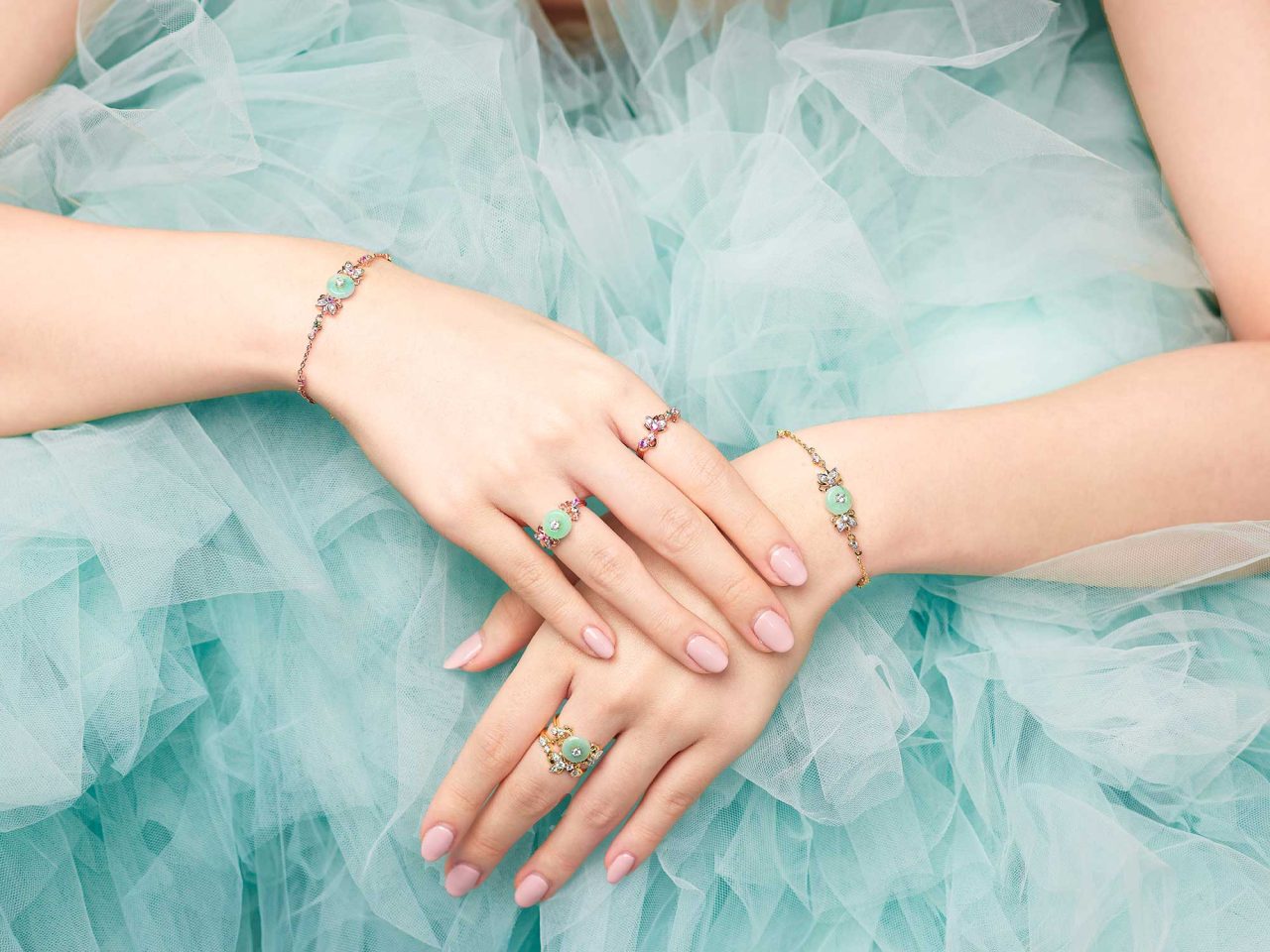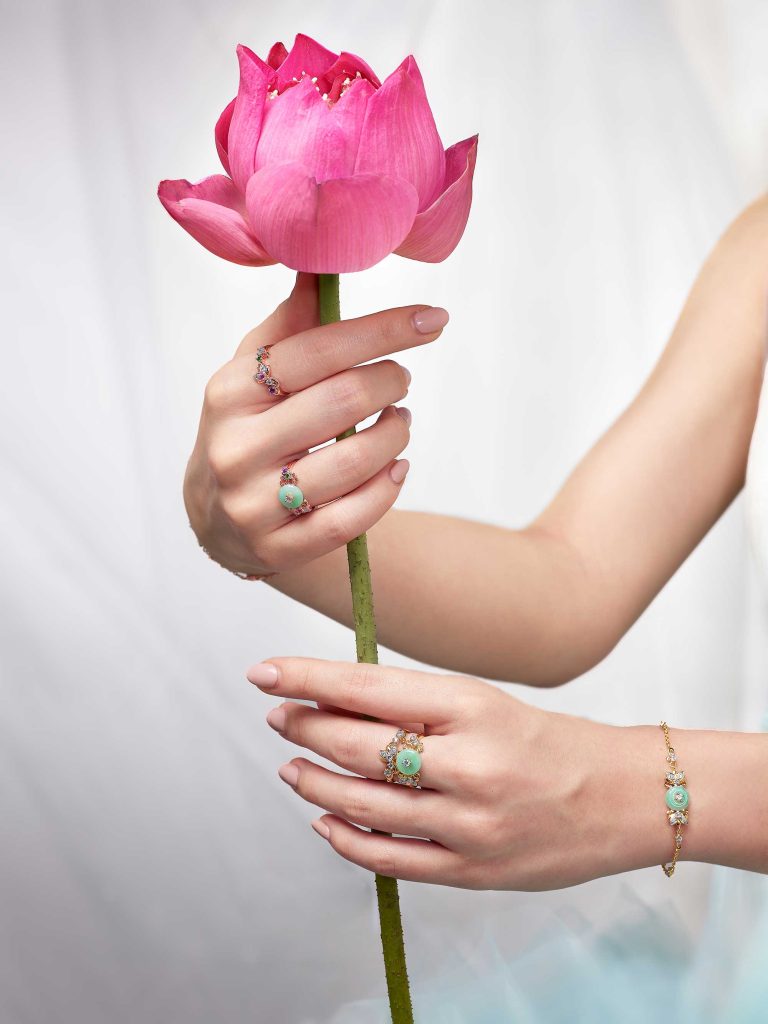
Local jeweller Carrie K has built a reputation for modern heirloom jewellery that reinterprets traditional gemstones and Chinese cultural symbols, from pearls to bats. Now, Carrie K founder and designer Carolyn Kan applies her artistic vision to jade and the lotus flower, with the brand’s new Lotus collection bringing together the ancient mineral and coloured sapphires for a contemporary reimagination—and it’s not the same green jade that elders favour.
“We do see that modern clients gravitate towards lighter shades [of jade], which is why we’ve introduced several pieces [featuring] the unique ice jade and lavender jade,” Kan explains. Here, she shares how jade can be updated for today, its significance in Chinese culture, and how to discern quality specimens.
GRAZIA Singapore: Jade has been making regular appearances in Carrie K’s collections over the years. What is it about jade that you’re attracted to?
Carolyn Kan (CK): Jade’s popularity can be traced back to ancient China; Confucius’s philosophies cemented its popularity, turning it into a symbol for virtue, kindness, wisdom, justice, civility, music, sincerity, truth, heaven and earth. Locally, many of us have been brought up to believe that jade wards off bad luck and evil, and brings health and good fortune in return. Because of these deeply ingrained histories, jade has always maintained a steady familiarity in Chinese and Asian cultures.

The traditional style of jade jewellery, though, seems to be falling out of favour with today’s consumers. Why do you think this is so?
CK: Jade jewellery was previously seen as old‑fashioned and something for grandmothers because they were only available in traditional, heavier‑looking designs. Dark green was also the shade of choice.
And how do you counter that at Carrie K?
CK: We’ve included updated jade designs to cater to present‑day tastes. In the past, people bought jade for its value. However, people now focus more on aesthetics. I’ve noticed that younger clients prefer contemporary and dainty designs, and gravitate towards lighter shades of jade due to their more modern look, so we’ve brought in ice jade and lavender jade, which we offer in a limited number of pieces in our new Lotus collection comprising decidedly more current designs.

We do see that clients now also prize versatility in their jewellery. They want to be able to dress it up or down and have it complement their various outfits and occasions. Our jade jewellery is thus designed specifically to be transformable, so clients can, for example, wear a pendant necklace or a pair of earrings on its own, or layer it with pendant or earring jackets to create a look that is both eye‑catching and refreshingly of the moment. Clients really like when there’s a modern twist to something previously perceived as traditional.

Share with us: What are some of the jade varieties that are becoming more popular now?
CK: Many different varieties of jade, apart from the usual green one, are becoming increasingly popular. Ice jade and lavender jade are two examples. As part of our Pearl Bar [accessories] line, we even offer several limited pieces of black jade, to cater to clients who like the history and significance of jade but prefer an edgier aesthetic.
There has been a recent rise in e‑commerce scams involving the sale of jade via Tiktok livestreams. Why is jade so susceptible to bad players?
CK: First, the quality of jade is not something that can be observed with the naked eye. While there are techniques for experts to determine the quality of a piece of jade, it is never guaranteed without a proper lab test. Second, there is a whole market of simulants that masquerade as jade—such as dyed quartz—because jade’s quality can only be determined by a lab test.

So not all jade is equal. Tell us more about the different grades of jade.
CK: Jade comprises two types of minerals: jadeite and nephrite. While there’s no consensus on grading nephrite, there are three grades of jadeite: Type A, Type B and Type C. Type A jadeite doesn’t go through any treatment; Type B jadeite undergoes mild treatment such as bleaching (which removes undesirable inclusions); Type C jadeite undergoes the same treatments as Type B but with additional dyed colouring (to enhance the hue). These differences can be revealed under UV light, and can also be identified by experts through the pitch of the jade’s resonance when struck.
We use only Type A Burmese jadeite (one of the highest‑quality variations of jade), and offer complimentary jade education sessions to clients to help demystify the precious stone. We find that many clients these days enter the store already educated and aware of what they want, so we want to supplement that information with a personal touch.
